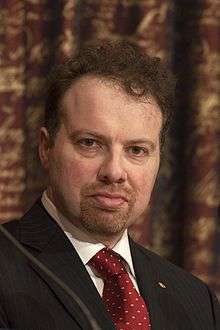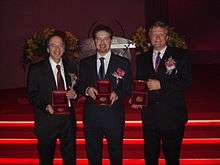Adam Riess
| Adam Riess | |
|---|---|
 | |
| Born |
Adam Guy Riess December 16, 1969 Washington, D.C., U.S. |
| Residence | United States |
| Nationality | United States |
| Fields | Physics |
| Institutions | Johns Hopkins University / Space Telescope Science Institute |
| Alma mater |
Massachusetts Institute of Technology, Harvard University, University of California, Berkeley |
| Known for | Accelerating universe / Dark energy |
| Notable awards |
Helen B. Warner Prize for Astronomy (2002) Shaw Prize in Astronomy (2006) Nobel Prize in Physics (2011) Albert Einstein Medal (2011) |
| Spouse | Nancy Joy Schondorf (m. 1998) |
Adam Guy Riess (born December 16, 1969) is a U.S. astrophysicist and Bloomberg Distinguished Professor at Johns Hopkins University and the Space Telescope Science Institute and is known for his research in using supernovae as cosmological probes. Riess shared both the 2006 Shaw Prize in Astronomy and the 2011 Nobel Prize in Physics with Saul Perlmutter and Brian P. Schmidt for providing evidence that the expansion of the universe is accelerating.
Family
Riess was born in Washington, D.C., one of three children.[1][2] He grew up in Warren, New Jersey, where his father (Naval engineer Michael Riess) owned a frozen-foods distribution company, Bistro International, and his mother (Doris Riess) worked as a clinical psychologist.[3] Michael Riess (1931–2007) immigrated to the United States with his parents (journalist, war correspondent and author Curt Riess and Ilse Posnansky)[4][5] from Germany on the ship SS Europa (1928) in 1936.[6] Adam Riess has two sisters— Gail Saltz, a psychiatrist, and Holly Hagerman, an artist. Riess married Nancy Joy Schondorf in 1998.
Education
He attended Watchung Hills Regional High School, graduating in the class of 1988.[7] He also attended the prestigious New Jersey Governor's School in the Sciences in 1987. Riess then graduated from The Massachusetts Institute of Technology in 1992 where he was a member of the Phi Delta Theta fraternity. He received his PhD from Harvard University in 1996; it resulted in measurements of over twenty new type Ia supernovae and a method to utilize Type Ia supernovae as accurate distance indicators by correcting for intervening dust and intrinsic inhomogeneities. Riess' PhD thesis was supervised by Robert Kirshner, and won the Robert J. Trumpler Award in 1999 for PhD theses of unusual importance to astronomy.[8]
Research
Riess was a Miller Fellow at the University of California, Berkeley, before moving on to the Space Telescope Science Institute in 1999. He took up his current position at Johns Hopkins University in 2006. He also sits on the selection committee for the Astronomy award, given under the auspices of the Shaw Prize. In July 2016, Riess was named a Bloomberg Distinguished Professor at Johns Hopkins University for his accomplishments as an interdisciplinary researcher and excellence in teaching the next generation of scholars.[9] The Bloomberg Distinguished Professorships were established in 2013 by a gift from Michael Bloomberg.[10]
Riess jointly led the study with Brian Schmidt in 1998 for the High-z Supernova Search Team which first reported evidence that the Universe's expansion rate is now accelerating through monitoring of Type 1a Supernovas. The team's observations were contrary to the current theory that the expansion of the universe was slowing down; instead, by monitoring the color shifts in the light from supernovas from Earth, they discovered that these billion-year old novae were still accelerating.[11] This result was also found nearly simultaneously by the Supernova Cosmology Project, led by Saul Perlmutter.[11] The corroborating evidence between the two competing studies led to the acceptance of the accelerating universe theory, and initiated new research to understand the nature of the universe, such as the existence of dark energy.[11] The discovery of the accelerating universe was named 'Breakthrough of the Year' by Science Magazine in 1998, and Riess was jointly awarded the 2011 Nobel Prize in Physics along with Schmidt and Perlmutter for their groundbreaking work.[11]
Riess leads the Higher-Z SN Search program which uses the Hubble Space Telescope to discover the most distant supernovae yet seen by humankind. His team has traced the Universe's expansion back more than 10 billion light years. The key finding has been the detection of an early phase of decelerating expansion causing the most distant supernovae to look relatively brighter and thus disfavoring significant astrophysical dimming of supernovae. This result thus confirms the dark energy-dark matter model as perceived from supernovae.
Awards

Riess received the Astronomical Society of the Pacific's Robert J. Trumpler Award in 1999 and Harvard University's Bok Prize in 2001. He won the American Astronomical Society's Helen B. Warner Prize in 2003 and the Raymond and Beverly Sackler Prize in 2004 for the discovery of cosmic acceleration.
In 2006, he shared the $1 million Shaw Prize in Astronomy with Saul Perlmutter and Brian P. Schmidt for contributions to the discovery of the acceleration of the universe.[12]
Schmidt and all the members of the High-Z Team (as defined by the co-authors of Riess et al. 1998) shared the 2007 Gruber Cosmology Prize, a $500,000 award, with the Supernova Cosmology Project (the set defined by the co-authors of Perlmutter et al. 1999) for their discovery of the accelerating expansion of the universe. Riess was the winner of MacArthur "Genius" Grant in 2008. He was also elected in 2009 to the National Academy of Sciences.[13]
Along with Perlmutter and Schmidt, he was awarded the 2011 Nobel Prize in Physics for his contributions to the discovery of the acceleration of the expansion of the universe.[12]
Riess, along with Brian P. Schmidt, and the High-Z Supernova Search Team shared in the 2015 Breakthrough Prize in Fundamental Physics.
Media appearances
Riess participated on the NPR radio quiz program Wait Wait... Don't Tell Me! in 2011.[14]
See also
References
- ↑ "WEDDINGS; Nancy Schondorf And Adam Riess". New York Times. January 11, 1998.
- ↑ Wedding: Drs. Gail Michele Riess and Leonard Bruce Saltz. Nytimes.com (June 18, 1989). Retrieved on April 2, 2012.
- ↑ Chasing the Great Beyond. Jhu.edu (January 12, 1998). Retrieved on April 2, 2012.
- ↑ Saxon, Wolfgang (May 21, 1993). "Curt Riess, Author And Journalist, 90; Expert on Nazi Era". New York Times.
- ↑ See also de:Curt Riess
- ↑ Obituary: Michael Riess. New York Times (October 11, 2007). Retrieved on April 2, 2012.
- ↑ Spivey, Mark. "Watchung Hills graduate shares Nobel Prize in physics", Daily Record (Morristown), October 4, 2011. Accessed October 5, 2011. "Riess, who grew up in Warren, gave a shout-out to retired teacher Jeff Charney, saying his interest in science first was piqued at Watchung Hills."
- ↑ Panek, Richard (2011). The 4% Universe: Dark Matter, Dark Energy, and the Race to Discover the Rest of Reality. Boston: Houghton Mifflin Harcourt. ISBN 978-0-618-98244-8., pg. 174
- ↑ Messersmith, Julie. "Nobel laureate Adam Riess named 22nd Bloomberg Distinguished Professor at Johns Hopkins", JHU Hub, Baltimore, 8 July 2016. Retrieved on 13 July 2016.
- ↑ "Michael R. Bloomberg Commits $350 Million to Johns Hopkins for Transformational Academic Initiative 2013".
- 1 2 3 4 Palmer, Jason (October 4, 2011). "Nobel physics prize honours accelerating Universe find". BBC. Retrieved October 5, 2011.
- 1 2 "Nobel physics prize honours accelerating Universe find". BBC News. October 4, 2011.
- ↑ Newsroom. National-Academies.org (April 28, 2009). Retrieved on April 2, 2012.
- ↑ Wait Wait...Don't Tell Me! from NPR
External links
| Wikimedia Commons has media related to Adam Riess. |
- Dark Energy Co-Discoverer Adam Riess Shares Shaw Prize in Astronomy for 2006
- Nobel Prize in Physics 2011 Announcement
- Chasing the Great Beyond
| Awards and achievements | ||
|---|---|---|
| Preceded by Konstantin Novoselov and Andre Geim |
Winner of the Nobel Prize in Physics with Saul Perlmutter and Brian Schmidt 2011 |
Succeeded by Serge Haroche and David J. Wineland |
